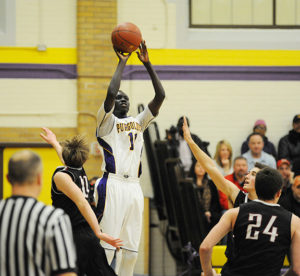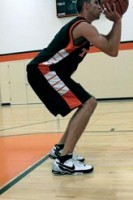Developing proper form for the mid-range jumper
The mid-range game is a major source of point production — if exploited properly.
 It’s an excellent complement to both the low-post and perimeter player, and it has a substantially higher success rate than shooting from 3-point land. When you consider that Kobe Bryant and Michael Jordan both scored most of their points with jump shots inside the arc, it’s easy to see how the mid-range game needs to play a major role in any offensive scheme.
It’s an excellent complement to both the low-post and perimeter player, and it has a substantially higher success rate than shooting from 3-point land. When you consider that Kobe Bryant and Michael Jordan both scored most of their points with jump shots inside the arc, it’s easy to see how the mid-range game needs to play a major role in any offensive scheme.
An overlooked shot
There are three reasons why the mid-range game is becoming a lost art form.1. The up-tempo game. More and more coaches are opting for an up-tempo game that focuses on getting the ball inside early in the possession for a high-percentage shot. If it’s not there, they take an early 3-pointer. The concept has merit as early transition defenses sink deep in the lane to protect the basket, leaving the perimeter vulnerable to wide-open looks.
Players and fans love this style of play because of the fast action, but how effective is it? It doesn’t take long for defenses to learn to get back and close up the inside. But what about the open 3-point attempts? Percentages prove that the success rate of shooting the 3-pointer early in transition is much lower — almost 50 percent lower — than shooting after reversing the ball several times. The reason is that the fast pace causes the athlete to have less body control, which in turn, creates more mistakes during the shooting motion.
2. The 3-pointer creates more drama. Let’s face it, knocking down a 3 provides a team and its fans with a much greater emotional lift than a 2-pointer. Because it’s the “grand prize” for points, the energy it generates is second only to the slam dunk.
3. Shooting the 3 is more challenging. Degree of difficulty is another reason the mid-range shot is less favored. It’s as if the arc taunts players — “Come on, go for it. Are you good enough?”
In tests of human behavior, a basketball was left on a gym floor and no supervisor was present. Almost every time the ball was picked up, the individual strolled out beyond the 3-point arc and launched a shot. Accepting a challenge is the nature of the beast.
A mid-range weapon
“What you practice” and “how you practice it” are the two main keys to developing the mid-range shot — in fact, any range shot.
Shot preparation and shooting mechanics are the two most important areas to perfect. A good beginning increases the chances for a successful ending. This is especially true with shooting.
Mid-range shots do not allow the luxury of a slow delivery, because most of the five defenders are inside the arc. Therefore, shot preparation is vital to be able to score.

Both the hands and feet need to be readied before the ball is caught. When the ball is in the air, the feet also are in the air (Photo 1).

When the feet land, they already should be in shooting position — pointing toward the basket, with the shooting foot slightly ahead for better balance (Photo 2).

The hands should be in shooting position, with off-hand fingers pointing to the ball, while the shooting-hand wrist is flexed with the index finger pointing straight up. The arms are extended to cushion the shock from receiving the pass and to give more time to gain control (Photo 3).

If strength is not an issue, the ball is caught and released high (Photo 4). The legs become the major power source, so they should be flexed. Younger players generally need to drop the ball lower due to lack of strength, but they still need to release the ball high to create proper arc.
A common mistake when catching and shooting after receiving the ball high is releasing the ball at the “top of the jump” instead of “on the way up.” This reduces power and arc, makes for a slower release, and results in more missed shots.









